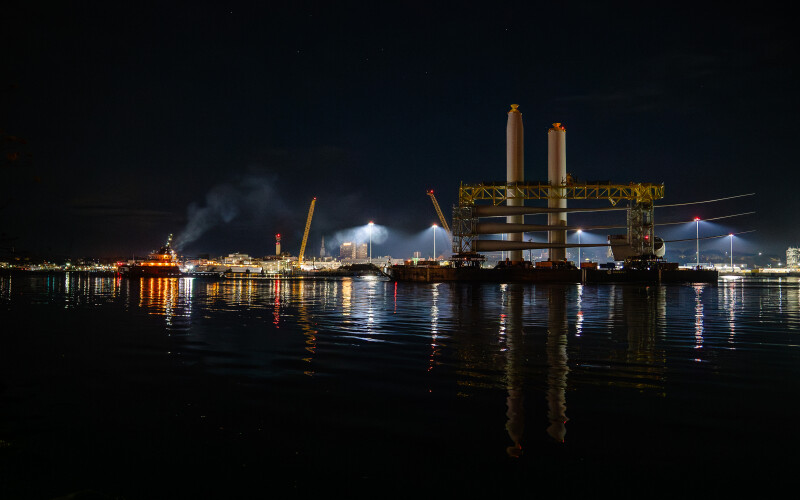As pleas for government assistance mount, the odds of 30 gigawatts of offshore wind power coursing through the nation’s transmission lines by 2030 are growing longer.
The pendulum has indeed swung against offshore wind as Northeast developers lump insufficient federal and state tax relief with skyrocketing costs, nagging supply chain bottlenecks and cumbersome permitting for, at best, delaying project start-ups. Ørsted’s bombshell decision on Oct. 31 to scrap two wind farms under development off New Jersey put a punctuation mark on a year that saw no less than 4.7 GW of planned wind power temporarily, or perhaps permanently scrapped.
That’s not to say some projects haven’t advanced on schedule, particularly for the consortiums that managed to lock in supplier contracts before inflation and interest rates rose. As of late November, a combined 932 megawatts of first power were on target to begin flowing through the grid at year-end 2023 from two wind farms off Massachusetts and New York. (The first of 12 turbines began delivering power in early December to New York’s Long Island Power Authority (LIPA) grid, marking the first utility-scale wind generation in U.S. federal waters.)
No new projects are scheduled to come online until 2025 when US Wind is expected to begin generating roughly 270 MW from its MarWin offshore wind farm off Ocean City, Md.
With some developers opting to pay hefty termination fees rather than proceed with what they say would be money-losing endeavors, the governors of six northeastern states sent a letter to President Biden in September appealing for assistance.
“Absent intervention, these near-term projects are increasingly at risk of failing,” wrote the Democratic governors of New Jersey, New York, Connecticut, Maryland, Massachusetts, and Rhode Island. “Without federal action, offshore wind deployment in the U.S. is at serious risk of stalling because states’ ratepayers may be unable to absorb these significant new costs alone.”
A measure of relief may be forthcoming from the 2022 Inflation Reduction Act, the Department of Energy said, which acknowledged the economic pickle developers face with the signing of iron-clad power purchase agreements (PPA) without an avenue for passing along spiraling costs.
“Many projects, particularly those with an expected start of commercial operations between 2025 and 2028, have faced challenges in maintaining economic viability because of rising capital costs and interest rates,” the Department of Energy said in its 2023 Offshore Wind Market Report. “The IRA may soften the adverse impact of rising inflation, supply chain restraints and interest rates on offshore wind project costs for early-stage offshore wind projects.”
With the latest Bureau of Ocean Energy Management (BOEM) lease sales, offshore wind energy touches every U.S. coastline, in some form or fashion. While California is working to establish a floating wind infrastructure, would-be developers in the oil and gas hub of the Gulf of Mexico are just trying to generate interest. Those areas can take a lesson from many northeast developers, which like Ørsted were saddled with non-negotiable rate agreements.
PULLING THE PLUG
Ørsted blamed “macroeconomic factors that have changed dramatically over a short period of time” for the abrupt decision to abandon its 1,100-MW Ocean Wind 1 and 1,148-MW Ocean Wind 2 wind farms that were scheduled to begin operation in 2025 and 2028, respectively. The Danish developer is contesting the legitimacy of a reported $300-million termination penalty.
Despite Ørsted haggling unsuccessfully for state relief, what may have been the final straw was a federal lawsuit led by New Jersey’s Cape May County that challenged the federal permits issued for the twin projects and set the stage for a likely conflict between pro-wind Gov. Phil Murphy and local interests.
Simultaneous with the cancellations, Ørsted and local partner Eversource made a final investment decision (FID) on the Revolution Wind farm off Rhode Island with a targeted 2025 completion date. Offshore construction is set to begin this year on the farm, which is designed to deliver 704 MW of power to Rhode Island and Connecticut.
Elsewhere, the developers behind two planned wind farms in Massachusetts and one in Connecticut agreed to pay a combined $114 million in termination fees to cancel earlier negotiated PPAs with hopes of later renegotiating better deals and resuming development.
On Aug. 23, Avangrid paid a $48 million penalty to scrap the 1.2-GW Commonwealth Wind farm in Massachusetts, and two months later shelled out roughly $16 million to abandon Connecticut’s 804-MW Park City Wind farm, originally scheduled to be commissioned in 2025. With the cancellations, the company avoided $2 billion in write-offs.
Avangrid has indicated no intention of permanently abandoning the leases but intends to negotiate for more economically viable PPAs.
“We have two high valuable leases ready to leverage and experience as part of the Iberdrola Group developing, financing and constructing offshore projects,” CEO Pedro Azagra Blázquez said in an Oct. 29 call, referencing the company’s Spanish parent. “We have two beautiful leases. They are worth a lot right now.”
On Aug. 23, partners Shell New Energies and Ocean Winds North America followed up on earlier warnings and agreed to pay a $60 million fine and cancel the PPA for the 1.2 GW South Coast Wind farm, also in Massachusetts.
In New York, the Equinor and BP consortium are proceeding for now with development of the 2,430-MW Beacon Wind 1 and Beacon Wind 2 and the 2.1-GW Empire Wind 1 and 2 farms, after the state quickly backpedaled and agreed to revisit its Oct. 25 refusal to adjust rate agreements.
“Last night, New York advanced an expedited renewable energy procurement process, as part of the (state’s) 10-point plan,” Equinor CFO Torgrim Reitan told analysts on Oct.28. “We welcome this, but it is important for me to say that our projects must be financially robust to proceed.”
New York also gave conditional approval in November for three wind projects in state waters that would have a combined 4 GW of production capacity. The proposed Attentive Energy One, Community Offshore Wind and Excelsior Wind farms are tentatively expected to be operational by 2030.
FIRST POWER
As the year was winding down, consortiums behind the Vineyard Wind 1 and South Fork Wind offshore wind farms were racing to see which would be first to flip the switch and bring commercial scale offshore wind energy to the U.S.
South Fork Wind was the winner. The first of 12 turbines for South Fork began delivering power Dec. 6 to New York’s Long Island Power Authority (LIPA) grid, marking the first utility-scale wind generation in U.S. federal waters. Meanwhile, the first five turbines for Vineyard Wind 1 have been installed and are expected to deliver 65 MW of energy by the end of the year.
“On Vineyard Wind 1, construction is progressing, and we are on track for delivering first power before the end of the year and achieving commercial operation by the end of 2024,” said Azagra Blázquez.
At full operation, Vineyard 1 will generate 800 MW of electricity from 62 turbines. South Fork wind’s 12 turbines will deliver a cumulative 132 MW of capacity.
To the south, what is to be the nation’s largest offshore wind farm remains on track for a 2026 start-up. Dominion Energy’s $9.8-billion Coastal Virginia Offshore Wind Project (CVOW) received final federal approval on Sept. 28, clearing the way for the installation of up to 176 turbines with a generation capacity of 2.6 GW. Like Vineyard and South Fork, Dominion lined up nearly all supplier contracts before prices spiked in 2022.
President and CEO Bob Blue said on Nov. 3 that construction of the Charybdis, the first Jones Act-compliant wind turbine installation vessel (WTIV), is “77% complete” at the Seatrium AmFELS shipyard in Brownsville, Texas.
NEW HORIZONS
With leases secured, the Biden administration is hoping the wind market will eventually expand to the deepwater West Coast and the Gulf of Mexico.
Aside from Maine, where a scaled-down pilot project is expected to begin churning out 12 MW of power this year, the floating wind sector is largely concentrated off California. The federal government’s multiagency Floating Offshore Wind Shot collaboration aims to reduce ratepayer costs to $45/MWh by 2035. “We see floating offshore wind as an enormous opportunity, given the magnitude of the resource we have in the U.S,” Jocelyn Brown-Saracino, the DOE’s offshore wind lead, said during an Aug. 30 Reuters webinar.
As California looks to create a new industry from scratch, prospective developers are trying to build a local supply chain. “We’re spending a lot of time reaching out to the suppliers in the area to really get a good handle on what their existing capabilities are and what things they need to increase their capabilities,” Robert Mastria, project director, offshore wind, for RWE Offshore Wind Holdings, said as part of the webinar panel. RWE Offshore was one of five provisional winners in the December 2022 federal wind lease sale offshore California with a high bid of $157.7 million.
In the Gulf of Mexico, BOEM plans to take another stab at attracting developers, with a yet-to-be-scheduled second lease sale with four optional areas encompassing 706,259 acres in Texas and 56,978 acres in Louisiana waters.
Hopes that the well-established oil and gas infrastructure would entice bidders faded as the inaugural sale on Aug. 29 drew a single high bid of $5.6 million by RWE Offshore US Gulf for a 102,480-acre lease off Louisiana.




